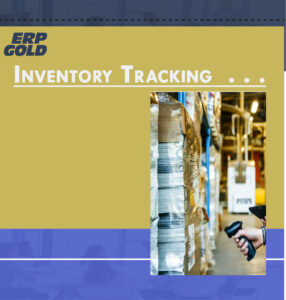What is Inventory Tracking?
Inventory tracking is how a company continually monitors its entire inventory. Inventory may be defined in various ways, although it is most typically used to refer to raw materials, unfinished things, and ready-to-sell commodities.
You may access data such as your precise inventory levels, the location of each item or SKU, updated delivery statuses, and other inventory-related information with inventory tracking. Inventory monitoring occurs in every firm that works with inventory, such as manufacturing and production organizations, warehouses, retail shops, and so on.
Inventory Tracking: Why it Is Important . . . ?
Typically, inventory monitoring systems can keep track of the following data:
-
Stock levels have been updated.
This number indicates how much of each item you presently own. It’s critical to maintain this data up to date to know whether you have adequate stock for your business activities, whether they’re creating new things or completing client requests. Furthermore, your stock levels serve as a foundation for the other recorded data.
-
Inventory locations Identification
In the best-case scenario, we should not keep your inventory in a single area for an extended period. (If it does, it has either become slow-moving or dead stock.) When goods enter your warehouse, it is sorted and categorized, then stored, and finally retrieved and transferred to the next step of your supply chain. Because your inventory isn’t kept in a permanent area, it’s critical to maintain track of its whereabouts, so you know where to look if you need it.
-
Inventory Precision – KPI
This is a key performance indicator (KPI) that refers to the ratio of inventory that has been monitored to inventory that is physically present in your possession. Both numbers should ideally be the same. However, there may be variations due to theft, damage, miscalculations, and supplier shortages.
Inventory accuracy will reveal the magnitude of the differences. Inventory accuracy, like stock levels, is critical to the seamless operation of your company operations.
-
Inventory Tracking Helps in identifying Carrying expenses
This is the entire amount of money spent on storing, keeping, and owning goods. This covers the amount you spend on rent, labor, storage, and related expenditures, as well as security. Carrying costs may inform you how long your company can continue to hold this inventory before it starts to cost money.
Slow-moving inventory and dead stock are two major contributors to high carrying costs, so if you want to cut those expenses, you’ll need to find a strategy to get rid of or sell the things.
-
Inventory valuation
When a company produces its financial accounts, this procedure determines the worth of unsold inventory. Inventory valuation assigns a financial value to your residual stock, which must be added to your balance sheet. This might also aid in the calculation of your inventory turnover.
Inventory turnover refers to the frequency with which your inventory is sold. A greater figure indicates better sales, whereas a lower value indicates worse sales. Inventory turnover can inform you how well your company is performing and if your sales strategy needs to be tweaked. To determine yours, use our free inventory turnover calculator.
-
Rearrange levels
A reorder point or level is the quantity of stock left for a certain item to be renewed or refilled. Reorder points are critical for avoiding stockouts (where a seller runs out of stock).
Inventory Tracking Technologies Being Used in 2022
Many of the problems that companies experience, such as running out of stock, having excess stock (which means tied-up capital), or having outmoded products or spoiling, are the consequence of inadequate inventory management. You boost your bottom line when you employ inventory management software with inventory control technologies. Using technology to supplement inventory management allows your company to keep on top of things by simplifying the ordering and monitoring process throughout a product’s sales cycle.
-
RFID (Radio Frequency Identification) Technology
RFID is an abbreviation for “radio-frequency identification,” and it refers to a technique that uses radio waves to collect digital data recorded in RFID tags or smart labels (described below). RFID is comparable to barcoding because data from a tag or label is taken by a device and stored in a database.
On the other hand, RFID provides several benefits over systems that employ barcode asset tracking software. The most significant difference is that RFID tag data may be read even when the tag is not in direct view, while we must align barcodes with an optical scanner.
RFID is one of a category of technologies known as Automatic Identification and Data Capture (AIDC). With little or no human interaction, AIDC techniques automatically recognize items, gather data about them, and input that data straight into computer systems. RFID systems do this by using radio signals.
-
LiFi (Light Fidelity) Technology
LiFi is a wireless communication system that uses light to convey data and location. LED bulbs are capable of transmitting visible light. In warehouses and factories, providing a wireless connection for many robots and electrical equipment is a difficult task.
LiFi has significant benefits over WiFi in certain circumstances and may be employed as a dependable wireless networking solution. Furthermore, visible light communication may enable precise 3D location for robots, drones, and other devices in warehouses and factories where indoor positioning and navigation are critical.
-
Barcodes system
We may find barcodes in various places, including identity cards, mail, and products purchased at a shop. For identifying reasons, a little picture of lines, bars, and spaces is mounted to practically anything you can think of.
Barcodes, in particular, employ a series of vertical bars and spaces to represent numbers and other symbols; a barcode normally consists of five parts:
- A quiet zone
- A start character
- data characters (often containing an optional check character)
- A stop character
- Another quiet zone.
When we are using barcode scanners, bar-coding improves efficiency and production in various sectors. Laser beams are used to scan barcodes and convert the reflected light into data, which is subsequently sent to a computer for action or storage.
Most people are acquainted with barcodes and barcode readers in supermarkets and retail businesses. However, barcodes are handy in various uses, ranging from inventory to book checkout to monitoring bees for study. In retail environments, barcode readers are often coupled to computers, but they are also mobile and portable for other tasks, such as scanning barcodes in warehouses and monitoring inventory.
Robotics Technology
New robots technology has quickly become one of the most sought-after warehouse management solutions. Leading manufacturers collaborate with warehouse management system suppliers to develop bespoke software and smart robots that aid in the transportation, storage, and sorting of warehouse goods.
With rising order volumes, a plethora of items to explore, more tailored order packaging, and speedier delivery needs, robotics solutions will enable businesses to successfully adapt to volume growth and execute more jobs with less manpower and at a lower cost.
The growing desire for better performance and flexibility in warehouse robots is driving some creative product development and early adoption of mobile warehouse robotics. As a warehouse manager, you should choose a robotic technology that meets all of your demands in terms of workflow.
Do you know what is inventory management software?
Inventory management software, as the name implies, helps businesses manage their inventory and guarantee they always have what they need on hand. It keeps track of inventory levels, sales, material purchases, and deliveries, enabling firms to anticipate how much stock they’ll need and compare it to what they presently have. Inventory software shortens the time it takes workers and company owners to monitor inventory levels and locate the resources they want, resulting in increased productivity.
Although solutions from various industries range significantly, most inventory management systems assist in automating and controlling any or all of the following areas:
- Optimization of inventory balance (maintaining the best mix and volume of items)
- Inventory cost management
- Inventory tracking across sites using barcodes, serial numbers, or Internet of Things devices that scan radio frequency ID (RFID)
- Purchasing fresh inventory
- Management of warehouses
- Product sales (in-store or online) are linked to inventory levels.
- Keeping spoilage and obsolescence at bay
- Taking care of fixed assets (equipment, facilities, vehicles)
- Forecasting and planning of demand
- Financial reporting that is accurate
Conclusion
The technology you choose is according to the nature of your company and the requirements you believe must be met. The simple truth is that inventory management is critical to your company’s existence. If You need any kind of assistance and guidance regarding inventory management and want automation for your inventory. ERP Gold provides a complete inventory management system for all kinds of small and medium-sized businesses.

